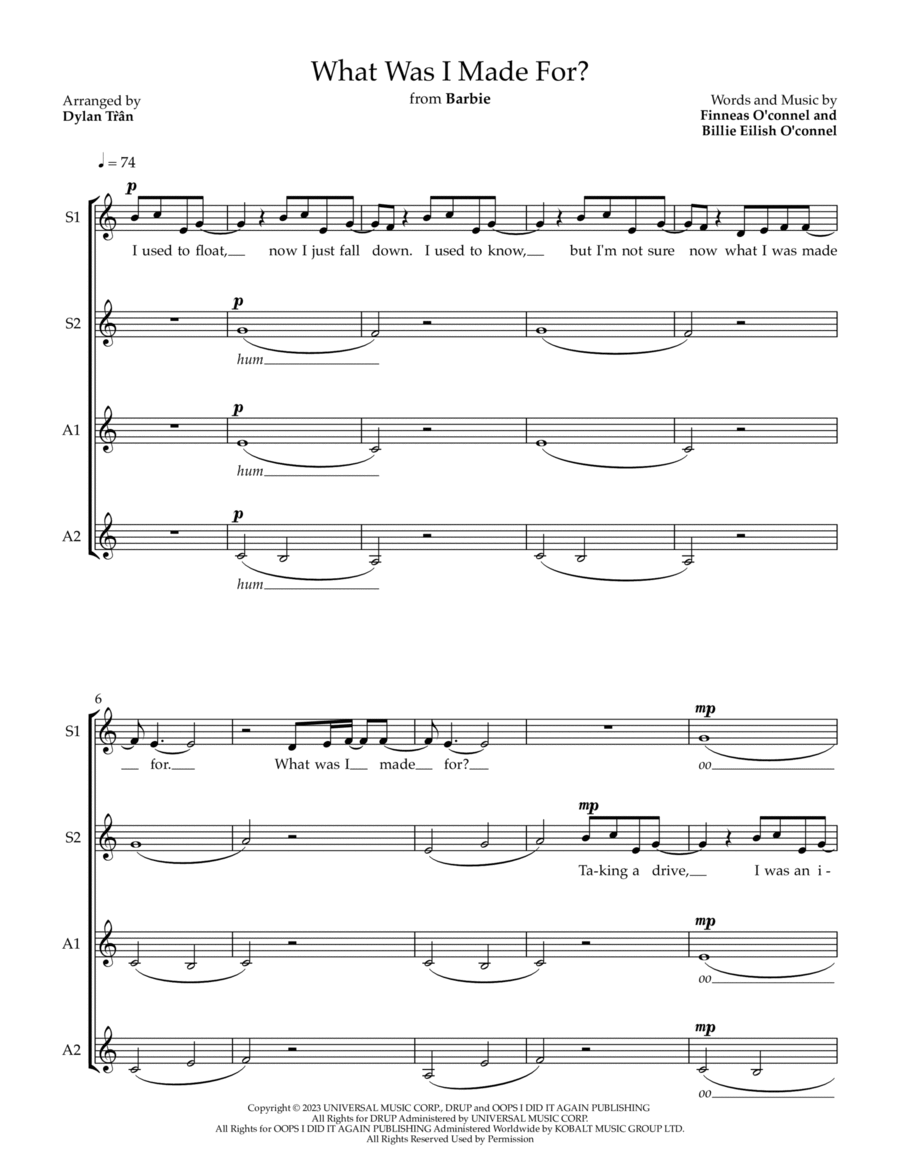Choral Choir,Choral (SSAA) - Level 2 - Digital Download SKU: A0.1280004 By Billie Eilish. By Billie Eilish O'Connell and Finneas O'Connell. Arranged by Dylan Tran. A Cappella,Contemporary,Film/TV,Pop,Singer/Songwriter. 7 pages. Dylan Trần #871424. Published by Dylan Trần (A0.1280004). Accesible yet moving, this arrangement of What Was I Made For? from the blockbuster movie, Barbie, is fit for professional choir, college choir, community choir, highschool choir, a capella groups, vocal pop groups, and more. Renowned composer Dylan Trần uses idiomatic, yet evocative voicings that will immediately reward on first reading as well as in polished performance. Learn more at www.dylantranmusic.comHere's why your choir should embrace Billie Eilish's captivating music— (professional choir, large ensemble, small ensemble, community choir, college choir, highschool choir, pop a capella choir, etc.)Contemporary Relevance: Billie Eilish's music is a cultural phenomenon, deeply resonating with today's generation. By incorporating her songs into your repertoire, your choir can connect with younger audiences, enhancing its relevance and expanding its fan base.Empowering Lyrics: Billie Eilish's lyrics tackle meaningful and often profound subjects, from mental health to self-discovery and social issues. Singing her songs empowers your choir to explore important themes, fostering empathy and emotional depth in their performances.Dynamic Vocal Range: Billie Eilish's music offers a diverse range of vocal styles, from hauntingly soft whispers to powerful belting. Your choir members can showcase their versatility and vocal prowess, honing their skills and challenging their vocal boundaries.Artistic Expression: Embrace the opportunity for creative expression! Billie Eilish's music encourages innovative interpretations, allowing your choir to infuse each performance with its unique artistic flair and captivate audiences with fresh renditions.Fusion of Genres: With elements of pop, alternative, and electronic music, Billie Eilish's songs provide an exciting fusion of genres. Your choir can explore new musical horizons, enriching its repertoire and broadening its musical diversity.Emotional Resonance: Billie Eilish's music evokes a wide range of emotions, from introspection to empowerment. Singing her songs allows your choir to tap into these emotions, forging a deep connection with audiences and leaving a lasting impact.Collaborative Learning: Billie Eilish's intricate compositions present an excellent opportunity for collaborative learning within your choir. By working together to master the nuances of her music, your choir members can strengthen their bonds and elevate their collective musicality.Pushing Boundaries: Billie Eilish's music is known for its boundary-pushing and innovative soundscapes. Embracing her songs encourages your choir to explore new musical territories, pushing the boundaries of traditional choral performances.Embrace the audacious spirit of Billie Eilish's music and witness your choir's performances soar to unprecedented heights of creativity and artistry. Unleash the power of her captivating melodies and thought-provoking lyrics, leaving audiences awestruck and craving more of your choir's extraordinary renditions.
